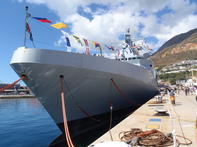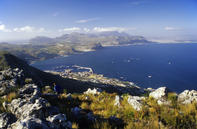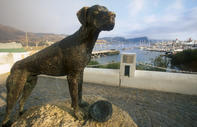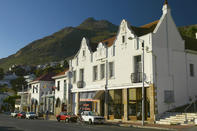Shops and More
With its long history of seafaring folk, a walk along the historical mile of Simon’s Town has great appeal for historians and boat-nuts alike. Shoppers will also be happy to walk through the old terraces, filled with quaint shops and food vendors.
On Jubilee Square there's a statue of Able Seaman Just Nuisance; his name makes more sense when you know it's a Great Dane who became renowned for looking after drunk sailors during the Second World War. He was actually officially enlisted into the British Royal Navy.
Make sure you visit the South African Naval Museum for some particularly interactive displays, the rocking bridge of a ship, for example, and the Simon's Town Museum, which is in the Governor's Old Residency. Finish off your tour with a walk to the East Dockyard and the Martello Tower, which was built in 1796 as part of the British fortification of Simon's Bay.
Boulders Beach Penguins

In terms of beaches, Simon’s Town has a beaut in the form of Boulders, just a few km down the road towards Cape Point. Ideal for families, Boulders is a magical beach surrounded by large, round rocks, with a great view up the coast towards Muizenberg. It is also well-protected from the wind and the sea is very calm. Plus, Boulders is the only beach in South Africa where humans and penguins share the same water.
In fact, it is the plucky penguins who casually stroll between the beach towels and bob through the human flotsam that are the main attraction of Boulders. Inevitably followed by a troop of wide-eyed kids, these little waterborne butlers seem quite unperturbed by their fellow bathers, and Boulders is a rare example of human beings actually sharing their environment with other creatures. The penguin colony extends to adjacent Foxy Beach, but this amenity is now closed for bathing, to give the penguins some privacy.
Admission is payable to enter Boulders and numbers are restricted as it is small. Additionally, when the sun starts to dip behind the tall rocks, the shadows creep quickly over the beach, so get there early. There are a couple of restaurants and small shops close by.
Simon's Town Naval Base

Simon’s Town is home to South Africa’s largest naval base. Here, the South African Navy houses training facilities for the frigates and submarines. Visitors can have an up-close look at some of South Africa’s best ships and submarines, as well as training facilities at the annual Navy Festival.
The Dutch East India Company first established a small dockyard facility in Simon’s Town in 1743. It was taken over by the British Royal Navy in the 1790s, under whom the facility was further developed. Adjacent to a pair of stone storehouses is the earliest Royal Naval building on the site: a combined mast-house, boathouse and sail loft. Dating from 1815, it now serves as the South African Naval Museum.
In the late 1800s, it became clear that more space would be needed to accommodate the requirements of a modern Navy. In 1898, a large site was acquired to the east of the original Yard for a dockyard extension. The new harbour construction began in 1900 and encompassed an area of 11 ha with a breakwater of 914 m in length. It also contained a drydock 240 m long and 29 m wide, with a sizeable steam factory constructed alongside. The drydock was named the Selborne Graving Dock after the Earl of Selborne, the High Commissioner of the Cape.
The naval base was eventually handed over to South Africa in 1957 under the Simon’s Town Agreement.
Elsie's Peak Trail

Elsie’s Peak is a very pleasant, easy walk affording wonderful views over Simon’s Town and False Bay and makes an excellent sundowner spot. There is no shade and no water available so go prepared. Park on Golconda, just off the Glencairn expressway, and head up on the access road that has a chain across it. The road swings to the left and you’ll see a footpath ahead of you. This leads to the top but is better as your descent route if you plan to do a circular trail.
Follow the gravel road up for about 500 m and then take a path to the right, marked by a large cairn, to the nek. Keep right at the Nek and head for the telecommunications mast near the summit. At the next junction, turn right again, following signs to Elsie's Peak, then right again when the path forks 30 m further on.
It is a glorious hike through lichen-covered weathered rocks and the going is easy, so take time to smell the flowers - the fynbos in this area is particularly rich and diverse thanks to the efforts of a local conservation group. The views from the summit are incredible.

